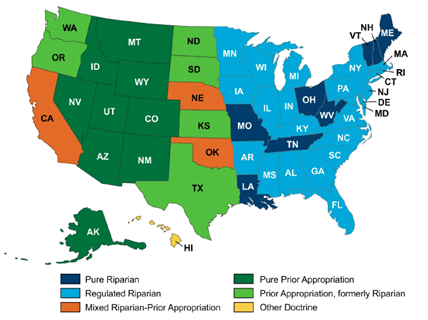
…jurisdiction over wetlands depends upon the existence of a significant nexus between the wetlands in question and navigable waters in the traditional sense.
Justice Kennedy (2006),
Legal decision from the Rapanos v. United States case
Laws and policies (at the national and state level, or international treaties among nations) determine which waters are protected and which are not. Laws and policies, and the institutions that implement them, are tailored to meet the unique needs of the nation, state, or local jurisdiction from which they originate. Despite inherent differences, there are commonalities among the laws, regulations, policies, and guidance that govern water. As stated in the text, the history of water rights – addressing “the use of and right to use water” – has evolved through time from Roman law. Today, most governance systems concerning water apply one of two rights: 1) riparian water rights, or 2) prior appropriation water rights. Riparian rights allocate water based on the proximity of those who own (or manage) the land adjacent to the water in question, whereas prior appropriation is based on a first-use basis. In the U.S., the eastern states tend toward riparian rights (allowing more public access). The western states, settled later, use a system of prior appropriation, where private ownership and access is determined by who got there first (Fig. 9.1).

As new challenges arise (such as climate change’s effect on freshwater systems), and new knowledge arrives (such as the contribution of small and isolated wetlands to nutrient cycling or animal life history), so must laws and policies evolve to be responsive.
In the U.S., the federal Clean Water Act (CWA) declares a goal to “restore and maintain the chemical, physical, and biological integrity of the nation’s waters,” (33 U.S.C. §1251(a)). This comprehensive law, passed in its current form in 1972, continues to be the primary means of restoring and maintaining water quality in the U.S. Along with the Safe Drinking Water Act of 1974, focusing on supplying potable water, water quality, in general, has improved over time. In addition, various state laws are aimed at protecting the waters of each state, or specifically at preventing pollution or degradation of those waters. Typical forms of regulation include permit requirements for certain activities (such as dredging or filling of streams, lakes, or wetlands), but just as typically contain exceptions and exclusions (frequently for practices associated with agriculture and forestry). Other nations with comprehensive environmental protections and programs have similar mechanisms in effect.